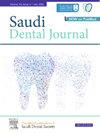Undergraduate dental curricula in Middle Eastern and Arabic-speaking African Nations − A cross-sectional study
IF 2.3
Q3 DENTISTRY, ORAL SURGERY & MEDICINE
引用次数: 0
Abstract
Purpose
To evaluate the design of undergraduate curricula, teaching and learning practices, assessments, admission criteria and quality assurance in dental schools across Middle Eastern and Arab-speaking African nations.
Methodology
A cross-sectional survey was sent to 40 dental colleges in the Middle East and African Arabic-speaking countries. A purposefully designed proforma consisting of 21 items divided into five sections based on admission criteria, curriculum delivery, teaching and learning practices, assessment methods, and quality assurance was used for data collection on Google forms. Participation in the survey was voluntary and all participants were consented before data collection. The data was analysed for descriptive statistics.
Results
A total of 28 dental institutions participated in the study yielding a response rate of 70 %. The data showed variations in the admission criteria, curricula, and assessment methods. The reliability statistics were satisfactory (Cronbach’s alpha = 0.89). ANOVA showed significant differences were noted in the clinical experience of students by country and curriculum design (p ≤ 0.001). Gaps were also identified in the quality assurance processes at some of the participating institutions.
Conclusion
This study provides a snapshot of undergraduate dental education in the Middle East and Arabic speaking African countries. Although a majority of the institutions follow a student-centered approach, some in institutions still follow the traditional teacher-centered approach which is not consistent with the contemporary strategies in healthcare education. The admission criteria are based on high school grades albeit with some variations. The duration of dental programs is five years at most institutions with or without an additional foundation year. Variations were also noted in the assessment weightings, clinical targets and quality assurance procedures. Further collaboration is required to facilitate harmonization of dental curricula in the region, solicit international recognition and to better support their graduates in pursuing postgraduate studies and employment options.
中东和讲阿拉伯语的非洲国家的本科牙科课程——一项横断面研究
目的评估中东和阿拉伯语非洲国家牙科学校的本科课程设计、教学实践、评估、入学标准和质量保证。方法对中东和非洲阿拉伯语国家的40所牙科学院进行横断面调查。谷歌表格的数据收集采用了有目的设计的形式,包括21个项目,根据入学标准、课程交付、教学实践、评估方法和质量保证分为5个部分。参与调查是自愿的,所有参与者在收集数据之前都得到了同意。对数据进行了描述性统计分析。结果共有28家牙科机构参与调查,调查回复率为70%。数据显示了录取标准、课程和评估方法的差异。信度统计令人满意(Cronbach’s alpha = 0.89)。方差分析显示,不同国家和课程设计的学生临床经验有显著差异(p≤0.001)。在一些参与机构的质量保证过程中也发现了差距。结论本研究提供了中东和阿拉伯语非洲国家本科牙科教育的概况。虽然大多数机构遵循以学生为中心的方法,但一些机构仍然遵循传统的以教师为中心的方法,这与当代医疗保健教育的策略不一致。录取标准以高中成绩为基础,尽管会有一些变化。大多数机构的牙科课程为期五年,有或没有额外的基础年。在评估权重、临床目标和质量保证程序方面也存在差异。需要进一步合作,以促进本区域牙科课程的统一,争取国际承认,并更好地支持其毕业生进行研究生学习和就业选择。
本文章由计算机程序翻译,如有差异,请以英文原文为准。
求助全文
约1分钟内获得全文
求助全文
来源期刊

Saudi Dental Journal
DENTISTRY, ORAL SURGERY & MEDICINE-
CiteScore
3.60
自引率
0.00%
发文量
86
审稿时长
22 weeks
期刊介绍:
Saudi Dental Journal is an English language, peer-reviewed scholarly publication in the area of dentistry. Saudi Dental Journal publishes original research and reviews on, but not limited to: • dental disease • clinical trials • dental equipment • new and experimental techniques • epidemiology and oral health • restorative dentistry • periodontology • endodontology • prosthodontics • paediatric dentistry • orthodontics and dental education Saudi Dental Journal is the official publication of the Saudi Dental Society and is published by King Saud University in collaboration with Elsevier and is edited by an international group of eminent researchers.
 求助内容:
求助内容: 应助结果提醒方式:
应助结果提醒方式:


